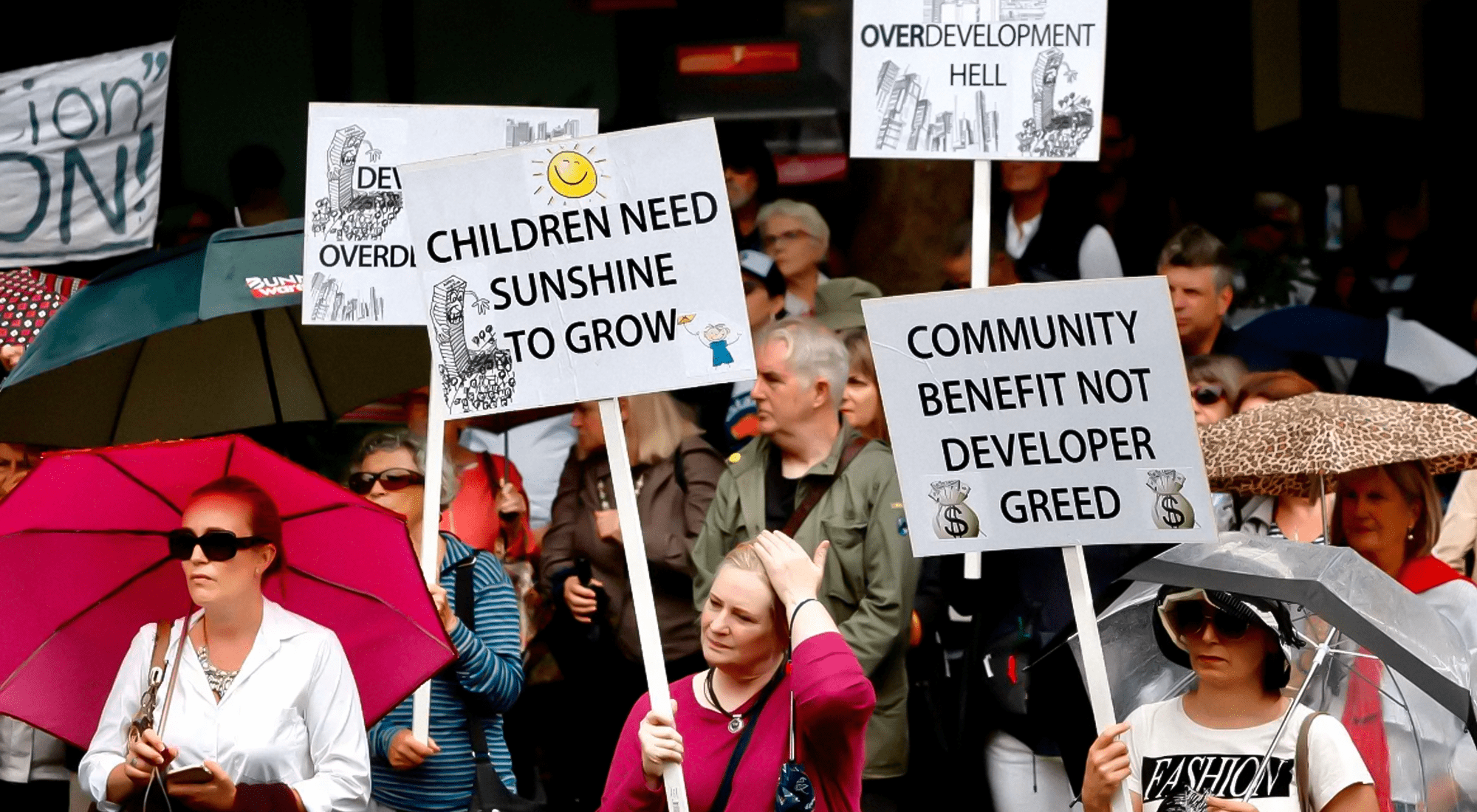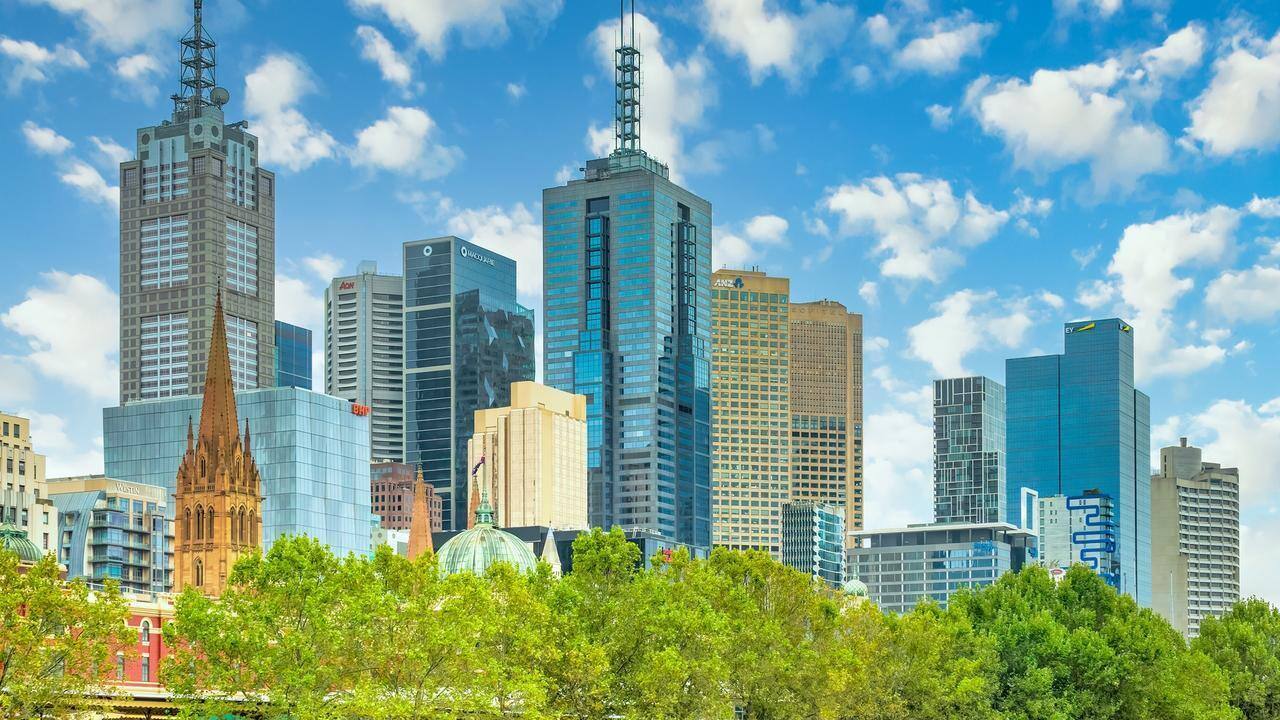Features > Property News & Insights > Housing Trends
Anti-development “NIMBY” Councils put on notice

KEY POINTS
- Proponents of higher-density housing are set to take an active role in council elections in Victoria later this year
- The group “YIMBY Melbourne” says inner and middle-ring councils are failing to deliver adequate housing for the city’s future population because of a NIMBY (Not In My Backyard) “calculus”
- YIMBY Melbourne says it wants to see 40,000 new homes built each year in Melbourne’s “missing middle”, with a focus on 3 to 8-storey apartment blocks close to shops and transport
- Two leading economists say NIMBY local councils have helped stymie sensible development in Australian cities, leading to the potential loss of more than a million homes over 20 years and entrenching the wealth gap
Campaigners for greater density in Australian cities are set to embark on their first big political test.
The lobby group YIMBY Melbourne says it will team up with social housing groups and ask candidates in October’s council elections in Victoria to sign pledges that they will not block housing developments that add to “diversity and choice” if elected.
YIMBY Melbourne, the most active of a handful of “Yes In My Backyard” groups in cities around the country, has made it clear that means securing pledges not to block multi-storey apartment developments in many of the city’s wealthy “middle ring” suburbs, including Toorak, Kew, Camberwell, Malvern, Caulfield and Hawthorn.
YIMBY Melbourne’s leader, Jonathan O’Brien, claims the group’s aim is to campaign “against the NIMBY (Not In My Backyard) calculus of local councils”.
The YIMBY wishlist
YIMBY Melbourne says that with the exception of the municipality of the City of Melbourne, which controls the CBD and neighbouring suburbs like Carlton and Docklands, “inner- and middle-ring councils are currently not doing enough to house Melbourne’s future population.”
In its manifesto, the group says this has “contributed to the city’s high reliance on greenfield development, which has seen more and more Melburnians pushed out toward our urban fringe” and helped stifle economic development.
“The land use patterns that our city needs—dense housing in high-amenity areas, within highly walkable neighbourhoods—are largely absent.”
“That is because, broadly, it is banned from being built.”
YIMBY Melbourne wants the state government to set a target of 40,000 new homes (predominantly in multi-storey apartment blocks) to be built in existing inner and middle Melbourne suburbs every year and enforce housing targets with councils.
It’s even published a map with the suggested number of new homes each local council should approve each year.

“All inner-city councils are going to be of interest to us (in the council elections) – especially those who have been systematically suppressing the delivery of homes where people want to live,” YIMBY Melbourne leader Jonathan O’Brien recently told The Sunday Age.
He singled out Boroondara Council in Melbourne’s inner-east which takes in the leafy suburbs of Kew, Camberwell and Hawthorn for special mention.
“For the sake of all Melburnians, it is essential that pro-housing councillors are elected in Boroondara,” he said.
Councils respond
Boroondara Council has claimed that of the more than 1,000 planning applications it receives each year, it refuses only 3 to 4%.
The Municipal Association of Victoria President David Clark has also said that merely approving more high-density developments doesn’t necessarily mean they’ll be actually built.
He recently told The Age newspaper that tens of thousands of council approvals secured by developers across Melbourne had not gone ahead, because of economic factors such as increased labour and materials costs.
Not just Melbourne…
Jonathan O’Brien and YIMBY Melbourne have plenty of heavyweight support for their thesis that councils have helped stymie the development of our cities and helped contribute to Australia’s current chronic housing shortage.
Last year, former Reserve Bank economist Tony Richards published a research paper claiming that Australia could have built 1.3 million more homes between 2001 and 2021 if it hadn’t been for state and local governments making developers navigate overly complicated planning, zoning and approval processes.
Another former RBA economist, Peter Tulip, has been scathing of local councils in his home city of Sydney, accusing them of pandering to NIMBY residents to entrench the wealth gap.
“Some planning restrictions reflect desire for social segregation by affluent residents,” he wrote in a paper entitled “Where should we build new housing? Better targets for local councils”.
“They have occupied the best real estate and do not wish to share it with renters, apartment dwellers or other newcomers.”
“Of course local councils oppose more density, and do so for spurious reasons.”
“When a block of flats replaces a house, 20 families get a roof over their head and their neighbour is overshadowed.”
“Councils ONLY represent that neighbour.”
The heritage argument is often brought up, particularly in the inner suburbs of Australian cities.
Jonathan O’Brien’s answer to that is blunt.
“Do we need to lock up upwards of 50% of our suburbs in the inner city under these heritage overlays that are restricting people from living where they want to live?” he told ABC News.
Stay Up to Date
with the Latest Australian Property News, Insights & Education.




.png?width=292&height=292&name=Copy%20Link%20(1).png)
 SIGN UP FOR FREE NEWSLETTER
SIGN UP FOR FREE NEWSLETTER








.jpg?width=1920&height=1080&name=Warning%2c%20You%20Might%20Be%20Facing%20Higher%20Taxes%20Soon%20(1).jpg)





.png?width=1920&height=1080&name=Rate%20Drops%20Signal%20BIGGEST%20Property%20Boom%20in%20DECADES%20(1).png)

.jpg?width=1920&height=1080&name=Labor%20vs%20Liberal%20These%20Housing%20Policies%20Could%20Change%20the%20Property%20Market%20Forever%20(1).jpg)
.jpg?width=1920&height=1080&name=QLD%20Slashes%20Stamp%20Duty%20Big%20News%20for%20Investors%20%26%20Home%20Buyers%20(1).jpg)
.jpg?width=1920&height=1080&name=Trump%20Just%20Slapped%20Tariffs%20%E2%80%93%20Here%E2%80%99s%20What%20It%20Means%20for%20Australia%20(1).jpg)
.jpg?width=1920&height=1080&name=Federal%20Budget%202025%20More%20Debt%2c%20No%20Housing%20%E2%80%93%20Here%E2%80%99s%20What%20You%20Need%20to%20Know%20(1).jpg)
.jpg?width=1920&height=1080&name=Australias%20Housing%20Crisis%20is%20about%20to%20get%20MUCH%20Worse%20(New%20Data%20Warns).jpg)
%20(1).jpg?width=1920&height=1080&name=Australias%20RENTAL%20CRISIS%20Hits%20ROCK%20BOTTOM!%20(2025%20Update)%20(1).jpg)
%20(1).png?width=1920&height=1080&name=Is%20Adelaide%20Still%20a%20Good%20Property%20Investment%20(2025%20UPDATE)%20(1).png)
.jpg?width=1920&height=1080&name=RBA%20Shocks%20with%20Rate%20Cuts!%20What%E2%80%99s%20Next%20for%20Property%20Investors%20(1).jpg)
%20(1).jpg?width=1920&height=1080&name=I%20Predict%20The%20Feb%20Rate%20Cut%20(My%20Price%20Growth%20Prediction)%20(1).jpg)
.png?width=1920&height=1080&name=Why%20Property%20Prices%20Will%20Rise%20in%202025%20Market%20Predictions%20(1).png)
.jpg?width=1920&height=1080&name=Why%20Investors%20Are%20Choosing%20Apartments%20Over%20Houses%202%20(1).jpg)
.jpg?width=1920&height=1080&name=Why%20Rate%20Cuts%20Will%20Trigger%20A%20Property%20Boom%20(1).jpg)
.jpg?width=1920&height=1080&name=Retire%20On%202Million%20With%20One%20Property%20(Using%20SMSF).jpg)
.jpg?width=1920&height=1080&name=4%20Reasons%20Why%20You%20Should%20Invest%20in%20Melbourne%20Now%20(1).jpg)
%20(1).jpg?width=1920&height=1080&name=Old%20Property%20vs%20New%20Property%20(Facts%20and%20Figures%20Revealed)%20(1).jpg)
%20(1).jpg?width=1920&height=1080&name=Will%20The%20New%20QLD%20Govt%20Create%20a%20Property%20Boom%20or%20Bust%20(My%20Prediction)%20(1).jpg)
%20Scott%20Kuru%20(1).jpg?width=1920&height=1080&name=Inflation%20Hits%20Three-Year%20Low%20(Will%20RBA%20Cut%20Rates%20Soon)%20Scott%20Kuru%20(1).jpg)
.jpg?width=1920&height=1080&name=How%20to%20Buy%20Investment%20Property%20Through%20SMSF_%20The%20Ultimate%20Guide%20(1).jpg)
.jpg?width=1920&height=1080&name=Victoria%20Slashes%20Stamp%20Duty%20Melbourne%20Set%20to%20Boom%20Scott%20Kuru%20(1).jpg)
.png?width=1571&height=861&name=Are%20Foreign%20Buyers%20Really%20Driving%20Up%20Australian%20Property%20Prices%20(1).png)
.jpg?width=1920&height=1080&name=The%20Single%20Factor%20That%20Predicts%20Property%20Growth%20Regions%20(1).jpg)
%20Scott%20Kuru%20(1).jpg?width=1920&height=1080&name=My%20Prediction%20On%20Rates%20%26%20Negative%20Gearing%20(Market%20Crash)%20Scott%20Kuru%20(1).jpg)

-1.png?width=1920&height=1080&name=Major%20Banks%20Cut%20Rates%20Will%20RBA%20Follow%20Suit%20(Sept%20Rate%20Update)-1.png)
%20Scott%20Kuru-1.png?width=1920&height=1080&name=Rate%20Cut%20Coming%20What%20New%20Zealands%20Move%20Means%20for%20Australia%20(Sept%20Prediction)%20Scott%20Kuru-1.png)
%20(1).jpg?width=1920&height=1080&name=Buy%20when%20the%20interest%20rates%20are%20high!%20(Why%20you%20must%20buy%20now!)%20(1).jpg)
.jpg?width=1920&height=1080&name=Carms_Revised%20Taxes%20Due%20Aug%209%20YT%20Thumbnail02%20(1).jpg)
.jpg?width=1920&height=1080&name=Carms_Too%20Little%20Too%20Late%20Aug%207%20YT%20Thumbnail01%20(1).jpg)









.jpg?width=1920&height=1080&name=Carms_Rate%20Drop%20In%20July%20Jun%2010%20YT%20Thumbnail02%20(1).jpg)
.jpg?width=1920&height=1080&name=Carms_Own%20a%20Property%20V6%20Jun%205_YT%20Thumbnail%20(1).jpg)









.png?width=1920&height=1080&name=Artboard%201%20(3).png)






.jpg?width=1920&height=1080&name=YT%20thumbnail%20%20(1).jpg)

